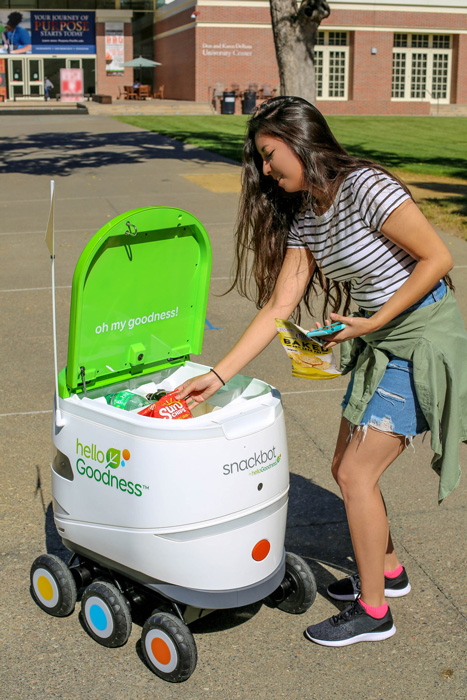Bots Deliver the Goods
STARTUPS & INNOVATORS
The food business originally lagged other industries in embracing digital innovation and transformation. But advanced drone technology and autonomous-vehicle (AV) startups now are catapulting grocery and restaurant delivery to the forefront of the digital revolution.
Take PepsiCo’s test of a “snackbot,” for instance. Called Hello Goodness, these cooler-sized AVs traversed the University of the Pacific in Stockton, Calif., in 2019 and delivered snacks ranging from Baked Lay’s chips to Pure Leaf tea to its 6,000 students.
“We identified a consumer need, a tension, which was the need for ease of accessing snacks and beverages on the go within a college campus,” says Andre Moraes, senior director of digital marketing for PepsiCo Foodservice. “And we met it with a solution that had a low [carbon] footprint, no interference, and fit well within the campus space.”
Hundreds of other early-stage bots and drones already are crisscrossing the last mile of population centers around the world, dropping off gyros sandwiches or pizzas to dorm rooms and skids of snack chips to supermarkets—in both pilot and early commercial phases.
“There will be humorously awkward moments where we’ll pull up at an intersection and run into two or three others testing delivery AVs, though the others have safety drivers,” says Matt Johnson-Robertson, chief executive officer of Refraction AI, which has a 25-bot fleet of delivery vehicles plying the streets of Ann Arbor, Mich., the college town where other AV experimenters include hometown pizza giant Domino’s.
Anand Gopalan explains food’s pole position in the growing delivery economy. “Grocery deliveries and medical supplies are the two areas driving adoption of autonomous delivery,” says the chief executive officer of Velodyne, a company that makes radar-based navigation equipment for autonomous vehicles. “Many food items have a short shelf life and require same-day delivery, so the robotic solution becomes very attractive.”
“We have to eat every day, and that kind of habitual consumption and regularity is a real driver for companies to be interested in AVs,” adds Daniel Davenport, director of the North American automotive practice for Capgemini consultants.
Food delivery occasions range widely, of course. Phases of food delivery include long-haul trucking, mid-range or regional distribution, and the so-called “last mile” that gets foods and beverages to consumers’ doorsteps or to the loading docks.
The fastest progress has come in last-mile deliveries to homes, fueled by COVID-19. Ground-delivery bots will account for the biggest share of the 2030 overall last-mile market as they do now, says a new report by Allied Market Research. They will be followed closely by aerial-delivery drones, with self-driving trucks and vans lagging significantly.
Bots are booming in part because “companies fear accidents from AVs based on automobiles, and liability insurance costs are really high,” Davenport says. “So if you take a smaller vehicle, moving much more slowly, you radically reduce the risk profile of an AV.”
But last-mile challenges include the need for sophisticated obstacle-avoidance systems for delivery drones working in complex urban environments. “Construction drones, for instance, operate within a manageable workspace, but food delivery drones need to move around pretty much boundlessly,” says Yoojung Hong, chief executive officer of This Is Engineering, a Seoul-based drone maker.
In the realm of regional distribution, the appeal of using AVs for “milk runs” on oft-repeated routes is that they require little decision-making by drivers, and their return on investment can be easily calculated. Gopalan expects to see a laser-based remote sensing technology called lidar rolled out commercially within two years in van-sized, driverless AVs that can “move goods from one microhub to another microhub.”
Walmart has experimented with a number of AV tech providers. Since 2018, for instance, the retail giant has been testing multi-temperature autonomous box trucks provided by startup Gatik for movement of goods on a two-mile route between a store-type fulfillment center and a small-format Walmart Neighborhood Market in Bentonville, Ark., Walmart’s headquarters town. Now they’re adding a 20-mile test route between New Orleans and Metairie, La.
For long-haul, “ramp to ramp” routes, startup Ouster, for instance, just announced a deal with Plus, a developer of automated truck tech to provide lidar sensors for a 1,000-vehicle fleet of 18-wheelers.


